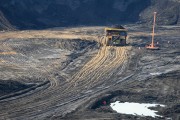First, it was the ducks and now it's the Na'vi: it's shaping up to be a tough week for the oilsands industry.
Already dealing with disturbing videos of ducks struggling in tailings lakes, which have emerged during Syncrude's trial, today the spotlight intensified as environmental and First Nations groups launched an ad in the Oscar edition of Hollywood's Variety magazine. Drawing parallels between the wildly popular movie Avatar (and its native people, the Na'vi) and the oilsands development unfolding in northeastern Alberta, the ad serves to further damage the image of the oilsands. This at a time when the Edmonton Journal was already commenting that the oilsands' image is "back in tar."
With lightning speed, Calgary Herald business columnist Deborah Yedlin and the Canadian Association of Petroleum Producers (CAPP) have tag-teamed to counter the groups' efforts. In Thursday's Herald Yedlin asserted that tying Avatar to the oilsands is a "fairy tale" and rambled through CAPP's talking points about all the benefits from oilsands development and the industry's dedication to protecting the environment. A few hours later CAPP rolled out their PR offensive and a media release to "invite these activists back to planet Earth to discuss the appropriate balance between environmental protection, economic growth and a safe and reliable supply of energy."
![]() This type of response has become par for the course, but what is surprising are Yedlin and CAPP's aggressive efforts to downplay, if not diminish, the concerns of First Nations groups, a number of which supported the Variety ad. It's worth picking these apart as they are a very superficial treatment of the benefits and costs of oilsands development for Aboriginal people.
This type of response has become par for the course, but what is surprising are Yedlin and CAPP's aggressive efforts to downplay, if not diminish, the concerns of First Nations groups, a number of which supported the Variety ad. It's worth picking these apart as they are a very superficial treatment of the benefits and costs of oilsands development for Aboriginal people.
Let's start with Yedlin's column, "Fairy tale realm no place for oilsands."
Yedlin feigned surprise that "a number of First Nations are supporting the ad, notwithstanding the fact more than 1,500 First Nations people hold full-time jobs in the oilsands and the fact that more than $3 billion has been netted by First Nations companies between 1998 and 2008."
The pace and scale of oilsands development and a lack of consultation prior to development is why Treaty 6, 7 and 8 First Nations have called for a moratorium on future oilsands development. Perhaps she wouldn't be as surprised had she spoken with any of the First Nations groups to learn why, from their perspective, these apparent benefits don't "balance out" their environmental and cultural concerns.
Next, Yedlin brazenly dismissed ongoing concerns in the community of Fort Chipewyan about the incidence of rare forms of cancer and possible linkages to oilsands development, writing: "As for those who want to talk about cancer rates in northern Alberta, that, too, has been exposed as an example of spurious correlation; the oilsands have nothing to do with what's going on in Fort Chipewyan."
 This assertion is just plain uninformed. A health study conducted by Alberta Health Services found residents of Fort Chipewyan experienced a higher incidence rate of cancers than expected, including higher rates of scientific significance for biliary cancers. And the study did not rule out the oilsands as a potential cause, noting that higher incidence rates could be "due to chance, to increased detection, or to increased risk (lifestyle, environmental or occupational) in the community." It went on to recommend continued monitoring and analysis. The jury is still out on this one as new scientific studies detailing oilsands contamination come to light.
This assertion is just plain uninformed. A health study conducted by Alberta Health Services found residents of Fort Chipewyan experienced a higher incidence rate of cancers than expected, including higher rates of scientific significance for biliary cancers. And the study did not rule out the oilsands as a potential cause, noting that higher incidence rates could be "due to chance, to increased detection, or to increased risk (lifestyle, environmental or occupational) in the community." It went on to recommend continued monitoring and analysis. The jury is still out on this one as new scientific studies detailing oilsands contamination come to light.
Moving on to CAPP's release, it noted: "Oilsands development does not go ahead without direct and meaningful Aboriginal consultation about both environmental impacts and economic benefits," while spokesperson Janet Annesly stated: "Aboriginal people are the oil and gas industry's neighbours, employees, contractors and stakeholders. Productive relationships are crucial to oil and gas companies earning their licence to operate."
It went on to provide a bulleted list of the economic benefits (the same cited by Yedlin) to First Nations members and companies. Notably absent was any mention of legal challenges related to oilsands development and First Nations consultation, rights and title, which are currently underway involving the Athabasca Chipewyan First Nation and the Beaver Lake Cree First Nation.
I've been fortunate to have the opportunity to spend time in many First Nations communities, from Fort McMurray, to Fort Chipewyan to remote communities in the Northwest Territories, and have heard the compelling concerns of many First Nations community members first-hand. During the past few years I've witnessed growing and united concern amongst First Nations about the tradeoffs being made between expanding oilsands development and the ensuing impacts on the environment, their communities and culture and traditional ways of life. It seems to me that all is not well with the oilsands industry's "neighbours" when they are asking financiers to stop bankrolling the projects.
As I've noted previously, so long as the oilsands industry and political leaders continue to believe that they have an "image" problem rather than an "impact" problem, the notion of anything remotely resembling responsible oilsands development will be little more than a fairy tale.










